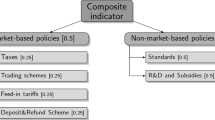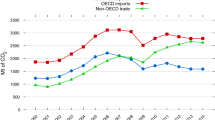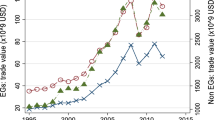Abstract
The paper empirically investigates whether developing countries may use trade policy as an alternative to environmental policies in order to control carbon emission. It measures the effectiveness of the existing ‘Most Favored Nations’ (MFN) tariff rates applicable to lower-middle income countries and for countries sorted on the basis of manufacturing-to-trade shares, in lowering carbon emission. By applying a fixed effects panel regression method over 16 years, it is found that the MFN tariff rate helps these economies to reduce carbon emission substantially. In addition, the role of foreign direct investment as purveyor of clean products is explored at the cross-country level. The results, at least on the ground of better environmental standards, indicate the need to re-evaluate the choice for protection under the domain of multilateral trade negotiations.




Similar content being viewed by others
Notes
A recent study on trade openness and national environment protection at the Yale Center for Environmental Law and Policy (2013) suggests that decision-making needs to move beyond the broad definitions of “trade openness” and “environmental performance”. Instead, it should recognize the importance of a more refined interplay between international trade flows, liberalization policies, good governance, and disaggregated environmental factors. The last factor includes environmental health, ecosystem degradation, and climate change.
Source: First article of the General Agreements on Tariff and Trade, see Basic Principles of Trade under WTO. We explain further on this in Sect. 1.1.
As an extension we also work with other countries on the basis of respective trade share in the world market.
Previously, it has been shown that high subsidies as a form of protection practiced in OECD countries can be explained by the adverse effects of ‘uniform tariffs’ across agriculture and industry in the developed countries (Marjit et al. 2007). The current study offers a greater degree of generality in terms of tariffs applicable to agriculture and manufacturing. In this structure (see Panagariya and Rodrik 1991) uniform tariff refers to a simplified and harmonized rate of tariff applied to imports from agriculture and industry, as opposed to differential rates. Uniform tariffs are usually advocated in the context of a small, open economy. It is suggested that for many developing countries, this constitutes a reasonable assumption. Panagariya and Rodrik (1991) note that the assumption allows one to abstract from positive optimal tariffs resulting purely from market power in the world markets.
PPM stands for Parts per Million.
The source is: The Role of Renewable Energy in Mitigating Climate Change in the ESCWA Region, U.N., New York (2012).
Regarding biases in relatively shorter panels for fixed effects model, see Buddelmeyer et al. (2008). In our case, \(N\) equals 5 and \(T\) equals 16.
This refers to internal combustion in diesel engines.
Acharyya (2009) examines the impact of FDI on carbon emission for India. Also see Feridun (2006). Acharyya (2009) finds that the long run growth impact of FDI inflow on carbon emissions is quite large. It is then expected that, \(\gamma _1 <0\). Other papers (viz. Smarzynska and Wei 2001; Hassabella 2013) find that the relationship is either non-negative or zero.
It should be pointed out that agricultural products (we do not include livestock) also emit other harmful greenhouse gases, such as, ammonia, nitrous oxide, etc. We look into these effects in a separate study.
We have referred to CGE models in Sect. 1.1, where changes in the stock of various factors of production, change in prices including trade reforms and inter-sectoral links provide more intricate theoretical results to be considered for empirical research in future.
We thank an anonymous reviewer for this suggestion.
References
Acharyya J (2009) FDI growth and the environment: evidence from India on \(\text{ CO }_2\) emission during the last two decades. J Econ Dev 33(1):43–58
Acharyya R, Kar S (2014) International trade and economic development. Oxford University Press, Clarendon
Andersson JO, Lindroth M (2001) Ecologically unsustainable trade. Ecol Econ 37(1):113–122
Bhagwati J (1993) Trade and the environment: the false conflict? In: Zaelke D (ed) Trade and the environment: law, economics and policy. Island Press, Washington
Braga P, Carlos A (1992) Tropical forests and trade policy: the case of Indonesia and Brazil. In: Low P (ed) International trade and environment. World Bank, Washington
Buddelmeyer H, Jensen PH, Oguzoglu U, Webster E (2008) Fixed effects bias in panel data estimators. IZA discussion paper no. 3487, Bonn, May
Carvalho TS, Santiago FS, Perobelli FS (2013) International trade and emissions: the case of the Minas Geraisstate—2005. Energy Econ 40:383–395
Cole MA, Rayner AJ, Bates J (1997) The environmental Kuznets curve: an empirical analysis. Environ Dev Econ 2(4):401–416
Copeland B, Taylor M (1994) North-south trade and the environment. Q J Econ 109(3):755–787
Dean JM (1992) Trade and the environment: a survey of literature. Policy research working papers # 966, world development report. World Bank, Washington, DC
Dong Y, Whalley J (2008) Carbon, trade policy and carbon free trade areas. National Bureau of Economic Research, working paper 14431. http://www.nber.org/papers/w14431
Dong Y, Whalley J (2011) Carbon motivated regional trade arrangements: analytics and simulations. Econ Model 28:2783–2792
Ederington J, Minier J (2003) Is environmental policy a secondary trade barrier? An empirical analysis. Can J Econ 36(1):137–154
Ederington J (2010) Should trade agreements include environmental policy? Rev Environ Policy Assoc Environ Resour Econ 4(1):84–102
Emerson JW, Esty DC, Srebotnjat T, Connett D (2013) Exploring trade and the environment: an empirical examination of trade openness and national environmental performance. Yale Center for Environmental Law and Policy report, Yale University
Feridun M (2006) Impact of trade liberalization on the environment in developing countries: the case of Nigeria. J Dev Soc 22(1):39–56
Frankel JA, Rose AK (2005) Is trade good or bad for the environment? Sorting out the causality. Rev Econ Stat 87(1):85–91
Francois J, Manchin M, Norberg H, Pindyuk O, Tomberger P (2013) Reducing transatlantic barriers to trade and investment an economic assessment. Final project report, March 2013. European Commission, Prepared under implementing Framework Contract TRADE10/A2/A16
Grossman GM, Krueger B (1993) Environmental impacts of a North American free trade agreement. The US-Mexico free trade agreement. MIT Press, Cambridge
Grossman GM, Krueger B (1995) Economic growth and theenvironment. Q J Econ 110(2):353–357
Hassabella H (2013) Environment and foreign direct investment: policy implications for developing countries. J Emerg Issue Econ Finance Bank 1(2):75–106
Horn H, Mavroidis PC (2001) Economic and legal aspects of the most-favored-nation clause. Eur J Polit Econ 17:233–279
Jaraite J, Maria CD (2012) Efficiency, productivity and environmental policy: a case study of power generation in the EU. Energy Econ 34:1557–1568
Kennedy PW (1994) Equilibrium pollution taxes in open economies with imperfect competition. J Environ Econ Manag 27:49–63
Marjit S, Kar S, Beladi H (2007) Trade reform and informal wages. Rev Dev Econ 11(2):313–320
Missios P, Yildiz HM (2006) The role of MFN under asymmetries in environmental standards. Econ Lett 93(2):297–304
Motta M (1992) Multinational firms and the tariff-jumping argument. A game theoretic analysis with some unconventional conclusions. Eur Econ Rev 36:1557–1571
Muhammad S, Samia N, Talat A (2011) Environmental consequences of economic growth and foreign direct investment: evidence from panel data analysis MPRA paper no. 32547 http://mpra.ub.uni-muenchen.de/32547/
Mukhopadhay K, Chakraborty D (2005) Is liberalization of trade good for the environment? Asia Pac Dev J 12(1):109–134
Panagariya A, Rodrik D (1991) Political-economy arguments for a uniform Tariff, NBER working paper #3661. NBER, Cambridge, MA
Rabindran SG, Jha S (2004) Environmental impact of India’s trade liberalization. doi:10.2139/ssrn.574161
Raff H (2004) Preferential trade agreements and tax competition for foreign direct investment. J Public Econ 88:2745–2763
Runge FC (1994) Freer trade, protected environment: balancing trade liberalization and environmental interests. Council on Foreign Relations Press, New York
Selden TM, Song D (1994) Environmental quality and development: is there a Kuznets curve for air pollution emissions? J Environ Econ Manag 27(2):147–162
Shafik N (1994) Economic development and environmental quality: an econometric analysis. Oxf Econ Pap 46:757–773
Smarzynska B, Wei S-J (2001) Pollution havens and foreign direct investment: dirty secret or popular myth? NBER working paper no. 8465, Cambridge, MA
Su B, Ang BW (2010) Input–output analysis of \(\text{ CO }_2\) emissions embodied in trade: the effects of spatial aggregation. Ecol Econ 70:10–18
United Nations (2012) The role of renewable energy in mitigating climate change in the ESCWA region. New York
Xing Y, Kolstad CD (2002) Do lax environmental regulations attract foreign investment? Environ Resourc Econ 21:1–22
Yao M, Shimada K (2015) Measuring environmental performance of industrial sector in China: an empirical analysis based on DEA approaches. https://scholar.google.co.in/scholar?cluster=5443504120504829085&hl=en&as_sdt=0,5&as_vis=1
Acknowledgments
The authors are grateful for very constructive comments by two anonymous reviewers of this journal. The paper has also benefited from presentations at the Delhi School of Economics and IIFT, New Delhi. The usual disclaimer applies.
Author information
Authors and Affiliations
Corresponding author
Rights and permissions
About this article
Cite this article
Kar, S., Majumdar, D. MFN Tariff Rates and Carbon Emission: Evidence from Lower-Middle-Income Countries. Environ Resource Econ 64, 493–510 (2016). https://doi.org/10.1007/s10640-015-9918-9
Accepted:
Published:
Issue Date:
DOI: https://doi.org/10.1007/s10640-015-9918-9




